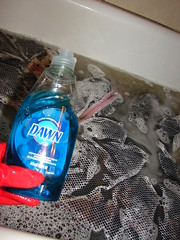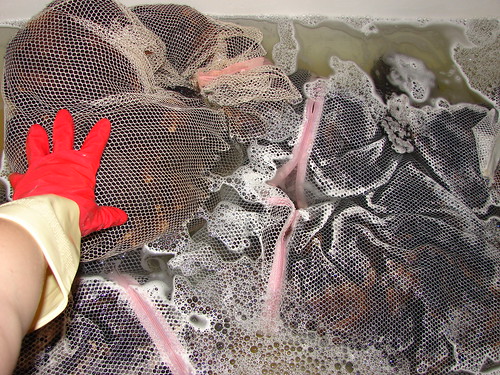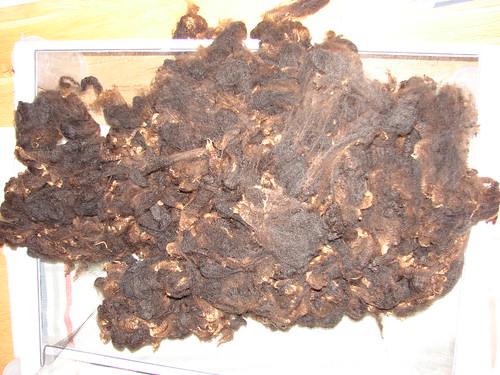My latest fleece acquisition is a gorgeous Cormo/Romney cross from the Maryland Sheep and Wool Festival. I got there early with my friend Dawn and we headed right for the fleece sale for some mad pawing and sorting through bags of fleeces (I'll get into choosing a fleece in another blog post). This one spoke to me- it has great crimp, it was super soft, had a long staple length (six inches relaxed!), and it was very clean.

Don't let the small sample fool you, the entire fleece was almost 8lbs! I was able to sell off a pretty good chunk via my Etsy store, but I left myself with at least 2 sweaters' worth, which is about 5 lbs raw.
Back to the washing.
What you'll need: A bathtub filled with hot hot hot water, a fleece scour or blue Dawn dish detergent, some lingere washing bags and rubber kitchen gloves.
The first thing you want to do is shake out and pick out any nasty bits and larger pieces of VM (vegetable matter) in the fleece. I do this outside on my front stoop since it can be quite messy. Most fleeces you buy at a sheep festival or from a reputable shepherd will be well skirted- meaning all the poopy bits and the fleece around their face have been thrown away. Still, some gets by on occsaion and I like to shake out any second cuts that might be in there. Then I'll grab a few handfuls and stuff it in the lingere mesh bags. You don't want to fill these too full or you won't get the fleece clean. Anything that doesn't make the cut, throw it in the compost pile- it makes for wonderful compost.

Sheep produce lanolin. This is a greasy, yellow-brown substance from their sebaucous glands which helps waterproof them. It's used commerically in hand creams and waterproofing. Depending on the breed of sheep, anywhere from 5-25% of the weight of the raw fleece is made up of lanolin. Working with raw fleece has the added bonus of making your hands soft, but it does have the drawbacks: it attracts moths, it will gunk up your spinning and carding equipment and it has quite the farmy odor to it. Not being a country bumpkin, I would like to get rid of this lanolin and run down the street to get a manicure to get my hands soft instead.
If you are able to turn your water heater up, now is the time to do so- you want the water to be around 140 degrees. I do not have this option, so I get a kettle on the stove and boil some water to add to the tub. The purpose of this is to melt the lanolin away. Once the tub 3/4 is full I cut the water, add my boiling kettle water and don my heavy-duty dish gloves (burns are bad).
About the Dawn soap: remember in the dishwashing ads how effective Dawn is at cutting grease? That's why it rocks at getting the lanolin out of you fleece. Also, it is PH neutral, so it won't strip too much of the good oils from your fleece. When birds and wildlife are caught up in an oil spill, rescue workers actually use Dawn to clean the oil off them, so I feel pretty good about using it on my fleece. Soaps that are too alkaline will open up the scales on the wool and increase your chances of felting. While they do sell specific wool-scouring soaps, they tend to be expensive and do the same job the Dawn does. Be sure that you get the plain old blue dawn with nothing fancy or new or improved on the lable. They do make several types of Dawn at this point- with bleach, antibacterial, nice smelling, etc., so be careful that you are picking up the right kind.

Once you have the tub full and the water off, gently squirt about a half a cup of the Dawn into the tub. The important thing here is you don't want bubbles-- they are a huge pain in the ass to try to rinse out. Use your begloved hand to gently stir the dawn in so the water is a lovely tropical blue that makes you want to jump in.
Take your bags of fleece. You don't want to overcrowd- i will usually only do 2-3 lbs at a time in the bathtub to make sure it gets clean. Gently sink them to the bottom of the tub. By the way, I'm sending you good vibes to make sure you don't felt this because, no matter how tempting it might be, you aren't going to touch these bags of fleece once they are wet. LEAVE THEM BE! After the original sinking to get them wet, you aren't allowed to touch them again. You will see lots of yellow-brown water seep out and your tub will start to get fine dirt and grit on the bottom.

Set your timer for 20 minutes. Spin, go for a walk, knit a few rows. After 20 minutes, carefully move the bags of fleece to the shallow end of the tub so the running water won't agitate them at all. Drain the tub, and press out the water from the bags a little to get the dirty out. Fill the tub again with hot water and repeat with the soap. The reason why you only do this for 20 minutes is that you don't want the water to cool so much that the lanolin will re-adhere itself to the fleece.
Once you've got a pretty clear tub, it's time to rise. Fill the tub up with clean, hot water, sink the bags down and leave them for 20 minutes.
Most fleeces I wash are good with 2 washes and 2 rinses. If you have a really crimpy dense fleece like merino, I would go ahead and do a 3rd wash.
I usually dump another boiling kettle down the drain after I'm done, just to make sure I won't have any congealed lanolin clogging the drain. It hasn't happened so far, but I'm pretty sure it's a possibility.
Tired yet? Scrubbed the bathtub clean of sheep dirt and grease? Good! You are almost done.
I don't have an outdoor space to dry, but if you do, take advantage. I set up an old window screen on top of 4 take-out soup containters and put a towel underneath so I don't ruin the floor. I press out as much water as i can from the bags of clean fleece and then empty the bags onto the screen. Don't be tempted to pull apart or try to fluff up the fleece too much or you will end up with nice clean felt. I turn the fleece over once or twice a day to make sure that it's all getting dry. Sometimes I set up a fan nearby to speed the process along.
Congratulations, now you have a clean fleece ready to be carded or combed and spun!

No comments:
Post a Comment